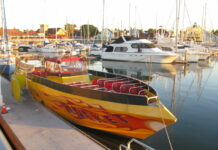Photo credit: DiasporaEngager (www.DiasporaEngager.com).
Trade missions can help firms to explore and gain a foothold in new overseas markets, and to establish new contacts. Between 2008 and 2022 there were 192 different trade missions under the leadership of a government minister or state secretary, and over 4 thousand Dutch firms participated in trade missions at least once.
Participation in a trade mission increases the likelihood that firms will do business in the host country by over 7 percent, and the likelihood that they will invest there by 2 percent. After receiving support of this kind, these new entrants go on to be just as successful as firms that have entered the relevant market of their own accord. In fact, firms that make a new investment following a trade mission remain active in the host country for significantly longer than firms that invest without having visited the relevant market first through a trade mission.
| Type of firm | ||
|---|---|---|
| Total | 7.2 | 2.3 |
| Independent SMEs | 8.9 | 2.2 |
| Large firms | 6.2 | 2.5 |
| Destination | ||
| OECD countries | 11.6 | 2.9 |
| BRICS countries | 15.4 | 4.7 |
| Developing countries | 0 | 0 |
| * Increase in likelihood that a participating firm begins trading or invests in host country within two years of taking part in a trade mission | ||
Trade missions are not just for large firms
On average, two-thirds of all participants in trade missions between 2008 and 2022 were independent SMEs. This share has risen over the years, from 63 percent in 2010 to 75 percent in 2022. On average, independent SMEs are more likely to start doing business in the host country within two years of a trade mission than large companies: 8.9 percent versus 6.2 percent.
Independent SMEs thus have the most to gain from taking part in a trade mission. This makes sense given the purpose of trade missions, which is to help firms gather information on potential suppliers, sales markets and local regulations, among other things. The firms that start out with the least information will typically have the most to gain from a trade mission, according to this study and similar academic research.
| 2008 | 1249 | ||
|---|---|---|---|
| 2009 | 795 | ||
| 2010 | 301 | 179 | 62 |
| 2011 | 431 | 236 | 94 |
| 2012 | 546 | 259 | 96 |
| 2013 | 715 | 390 | 110 |
| 2014 | 368 | 231 | 68 |
| 2015 | 498 | 269 | 67 |
| 2016 | 497 | 220 | 61 |
| 2017 | 275 | 112 | 43 |
| 2018 | 349 | 172 | 54 |
| 2019 | 331 | 169 | 40 |
| 2020 | 273 | 127 | 37 |
| 2021 | 246 | 95 | 24 |
| 2022 | 215 | 73 | 11 |
Particular interest in trade missions to China and India
A total of 63 different countries were visited during the period under study. China, which received twelve trade missions with a total of 656 participants, was the most visited destination, followed by India and Vietnam. The ‘BRICS’ countries (Brazil, Russia, India, China and South Africa) all feature high on this list. Of all the countries visited, the likelihood of business activity following a trade mission to a BRICS country was the highest, at 15.4 percent.
The fact that missions to BRICS countries have a higher chance of success can also be explained by the greater need for information on these countries. In countries where it is already easy to do business, such as OECD countries, trade missions are of limited added value. However, trade missions to other developing countries appear to have no significant effect on the likelihood of participating firms doing business there.
| China | 656 |
|---|---|
| India | 623 |
| Germany | 504 |
| USA | 495 |
| Vietnam | 445 |
| Brazil | 389 |
| Indonesia | 353 |
| Turkey | 336 |
| Russia | 316 |
| Japan | 300 |
| France | 222 |
| South Africa | 216 |
| United Arab Emirates | 191 |
| Poland | 170 |
| South Korea | 164 |
| Belgium | 156 |
| Colombia | 150 |
| Mozambique | 120 |
| Iran | 116 |
| Saudi Arabia | 101 |
| 1)With at least 100 participating firms | |
The Netherlands is a small country with a small domestic market. About one-third of our GDP is earned abroad through exports. This makes it more attractive for Dutch firms to pursue business opportunities beyond our borders.
In addition to studying the effectiveness of participating in trade missions for firms wishing to do business in or invest in other countries, the effect of trade missions on firms already operating in the destination country was also examined. The extent to which the effectiveness of economic missions is associated with whether the participating firm sends a man or a woman on a trade mission was also examined. The findings are outlined in the research report entitled: ‘Follow-up research on government-led economic missions’ (only available in Dutch).
Source of original article: Statistics Netherlands (CBS) (www.cbs.nl).
The content of this article does not necessarily reflect the views or opinion of Global Diaspora News (www.GlobalDiasporaNews.com).
To submit your press release: (https://www.GlobalDiasporaNews.com/pr).
To advertise on Global Diaspora News: (www.GlobalDiasporaNews.com/ads).
Sign up to Global Diaspora News newsletter (https://www.GlobalDiasporaNews.com/newsletter/) to start receiving updates and opportunities directly in your email inbox for free.


































